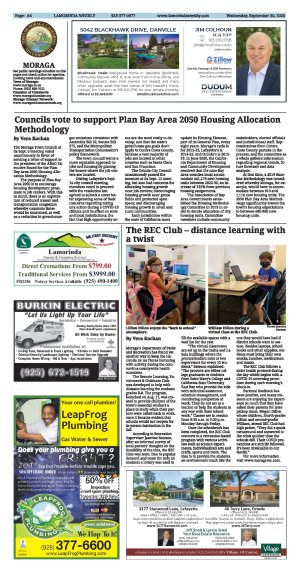| | Published September 30th, 2020
| Councils vote to support Plan Bay Area 2050 Housing Allocation Methodology
| | | By Vera Kochan | | |
The Moraga Town Council at its Sept. 9 meeting voted unanimously in favor of sending a letter of support to the president of the ABAG Executive Board for the Plan Bay Area 2050 Housing Allocation Methodology.
 The purpose of Plan Bay Area 2050 is to encourage housing development proximate to job centers. With this in mind, there is an expectation of reduced transit and transportation congestion whereby commute times would be shortened, as well as a reduction in greenhouse gas emissions consistent with Assembly Bill 32, Senate Bill 375, and the Metropolitan Transportation Commission's policy framework.
The purpose of Plan Bay Area 2050 is to encourage housing development proximate to job centers. With this in mind, there is an expectation of reduced transit and transportation congestion whereby commute times would be shortened, as well as a reduction in greenhouse gas emissions consistent with Assembly Bill 32, Senate Bill 375, and the Metropolitan Transportation Commission's policy framework.
 The town council wants a more equitable approach to jobs and housing by placing the homes where the job centers are located.
The town council wants a more equitable approach to jobs and housing by placing the homes where the job centers are located.
 During Lafayette's Sept. 14 city council meeting, members voted to proceed with the resolution but agreed to submit a cover letter expressing some of their concerns regarding taking any action during a COVID-19 climate and its effect on state and local jurisdictions; the fact that high opportunity areas are the most costly to develop; and that the state's greenhouse gas goals don't apply to Contra Costa County, because a vast majority of jobs are located in other counties such as Santa Clara and San Francisco.
During Lafayette's Sept. 14 city council meeting, members voted to proceed with the resolution but agreed to submit a cover letter expressing some of their concerns regarding taking any action during a COVID-19 climate and its effect on state and local jurisdictions; the fact that high opportunity areas are the most costly to develop; and that the state's greenhouse gas goals don't apply to Contra Costa County, because a vast majority of jobs are located in other counties such as Santa Clara and San Francisco.
 The Orinda City Council unanimously passed the measure at its Sept. 15 meeting, but also had concerns for allocating housing growth near job centers; discouraging housing growth near green fields and protected open space; and discouraging housing growth in small and rural communities.
The Orinda City Council unanimously passed the measure at its Sept. 15 meeting, but also had concerns for allocating housing growth near job centers; discouraging housing growth near green fields and protected open space; and discouraging housing growth in small and rural communities.
 Each jurisdiction within the state of California must update its Housing Element, part of its General Plan, every eight years. Moraga's cycle is for 2015-23, Lafayette's is 2014-22, and Orinda's is 2015-23. In June 2020, the California Department of Housing and Community Development resolved that the nine Bay Area counties must accommodate 441,176 new housing units between 2022-30, an increase of 135% from previous housing assignments.
Each jurisdiction within the state of California must update its Housing Element, part of its General Plan, every eight years. Moraga's cycle is for 2015-23, Lafayette's is 2014-22, and Orinda's is 2015-23. In June 2020, the California Department of Housing and Community Development resolved that the nine Bay Area counties must accommodate 441,176 new housing units between 2022-30, an increase of 135% from previous housing assignments.
 The Association of Bay Area Governments established the Housing Methodology Committee in 2019 in order to decide allocation of city housing units. Committee members include community stakeholders, elected officials and jurisdictional staff. Representatives from Contra Costa County partake in the process, and the committee as a whole gathers information regarding regional trends, future forecasts and data analysis.
The Association of Bay Area Governments established the Housing Methodology Committee in 2019 in order to decide allocation of city housing units. Committee members include community stakeholders, elected officials and jurisdictional staff. Representatives from Contra Costa County partake in the process, and the committee as a whole gathers information regarding regional trends, future forecasts and data analysis.
 At that time, a 2019 Baseline Methodology was considered whereby Moraga, for example, would have to accommodate between 910 and 1,110 new housing units. The 2050 Plan Bay Area Methodology significantly lowers the town's housing expectations to between 680-860 new housing units.
At that time, a 2019 Baseline Methodology was considered whereby Moraga, for example, would have to accommodate between 910 and 1,110 new housing units. The 2050 Plan Bay Area Methodology significantly lowers the town's housing expectations to between 680-860 new housing units. |
| | | | | | | | | | | | |


